From the 1985 BMW M3 to the 2025 M2: A journey through sporting tradition

August 2025. I hit the red 'stop' button and the sound, the growl of the engine, fades away and I get out of the car...
- How many horses? - I hear next to me
The gas station attendant, an old acquaintance, has replaced the usual question, "How much do we need?", with this one prompted by the scene before him. The image of a spectacular front end, with large air intakes that cool and feed the engine, extra-wide 19-inch tires at the front and 20-inch tires at the rear, mounted on ten-spoke aluminum wheels surrounded by flared fenders, quad exhausts, impressive bucket seats, a carbon-fiber roof...
-480… and forty years…
-Forty years...? - he asks in surprise
-Yes, forty years of experience…
And as the pump begins to fill the tank of my 2025 BMW M2, my mind travels back to September 12, 1985.
Yes, the doors of the 51st Internationale Automobil-Austellung (IAA'85), the Frankfurt Motor Show, have just opened, and on the BMW stand is a very special model, technically called the E30 M3.
In the 1980s, BMW experienced a pivotal moment: it aimed to dominate the World Touring Car Championship. So the men at BMW Motorsport, the Bavarian firm's racing department, set to work designing a car that went far beyond adapting a road-going model.
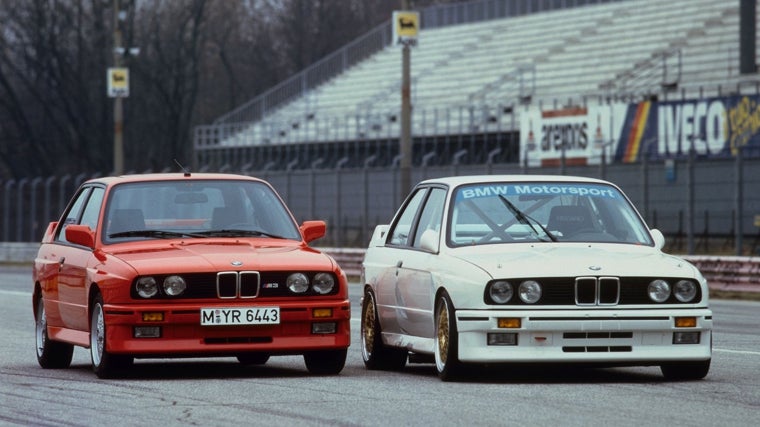 The idea was to build a production car, approved in Group A, to have a winner in touring car competitions.
SGC
The idea was to build a production car, approved in Group A, to have a winner in touring car competitions.
SGC
They want to build a lightweight and powerful racing car. But to obtain Group A homologation, they must produce 5,000 road-going cars in twelve consecutive months before being able to take their car on the track.
They're based on the standard two-door E30 BMW 3 Series. But that's just the starting point. They leave the fenders exposed to accommodate wider wheels and allow for a wider track. In addition, the trunk lid, now made of fiberglass-reinforced plastic, is raised a few centimeters, and a shorter rear window is installed. At the same time, a large rear spoiler is added, adjustable on the Evolution models. The bumpers and side skirts are striking. It's not easy to achieve the compromise between "sticking" the car to the road while simultaneously reducing air resistance.
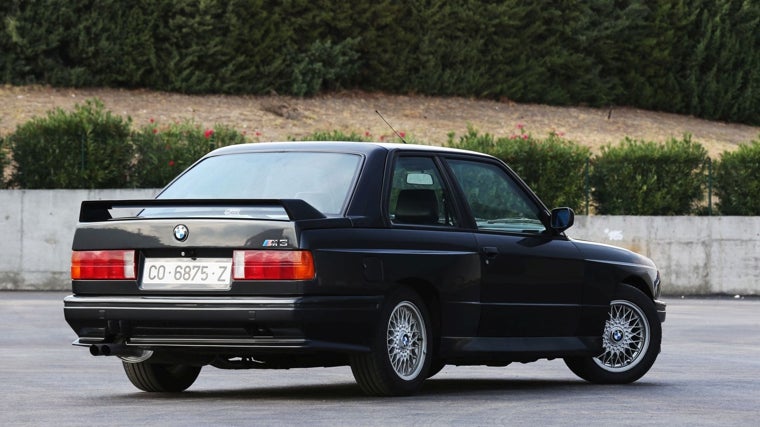 For aerodynamic reasons, the trunk lid was higher and also had a spoiler.
SGC
For aerodynamic reasons, the trunk lid was higher and also had a spoiler.
SGC
But compared to the 0.38 of a stock BMW 3 Series, the aerodynamic drag coefficient was 0.33, a very good figure for the time.
Chassis improvements come via the usual channels. The spring and damper settings have been stiffened, the stabilizer bars have been thickened, and the center of gravity has been lowered. The front axle has a modified caster angle. Behind the 15-inch, five-stud BBS wheels are the more robust stub axles and wheel bearings from the 528i, as well as upgraded brakes (280 mm ventilated discs at the front and 282 mm solid discs at the rear) with a Bosch ABS system.
When developing the engine, BMW Motorsport would apply all its experience, including that gained with the Brabham Formula 1 team, with which Neson Piquet won the title in 1983. Instead of choosing a more powerful six-cylinder engine as a starting point, Paul Rosche, then technical director of BMW M GmbH, opted for a four-cylinder not only to save weight, but also because the crankshaft of the six-cylinder of the time was giving them some problems, read vibrations, at medium and high revs.
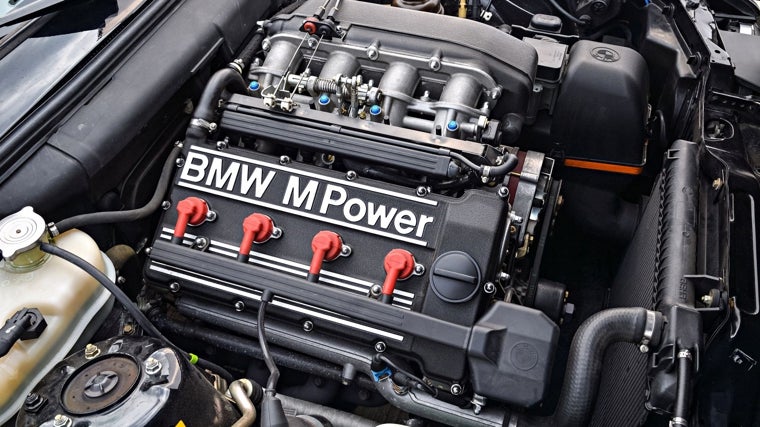 For the engine, a four-cylinder iron block was chosen, with the cylinder head, shortened, from the six-cylinder M1
SGC
For the engine, a four-cylinder iron block was chosen, with the cylinder head, shortened, from the six-cylinder M1
SGC
The new engine was based on the iron block of BMW's production two-litre (93.4 x 84 mm) four-cylinder engine (whose origins dated back to the BMW 1500 of the 1960s), but with a long-stroke crankshaft and a larger bore, resulting in a larger displacement of 2302 cc. This engine was fitted with a shortened version of the four-valve-per-cylinder cylinder head borrowed from the M1 and M635CSi, fitted with Bosch Motronic fuel injection. It initially produced 200 hp at 6,750 rpm, delivered to the rear.
It's important to note that with the M3 weighing 1,200 kilos (52% front and 48% rear), the power-to-weight ratio was 6 kilos per horsepower. In the competition version, 300 hp and even higher revs were possible. Surprisingly, the first prototype engine would take only 14 days to get up and running, hence the "S14" designation.
Racing technology is also incorporated into the transmission. A close-ratio Getrag five-speed is fitted as standard, with 1st gear on the lower left, so 2nd and 3rd are in line, as are 4th and 5th, for faster shifting. Interestingly, this gearbox was not installed in the M3 vehicles destined for the US market.
And in Munich, the distrust they had of American drivers when it came to handling manual transmissions was exacerbated in this case by the different gear arrangement: they had to avoid accidents caused by accidentally shifting into reverse at traffic lights... and the associated civil lawsuits.
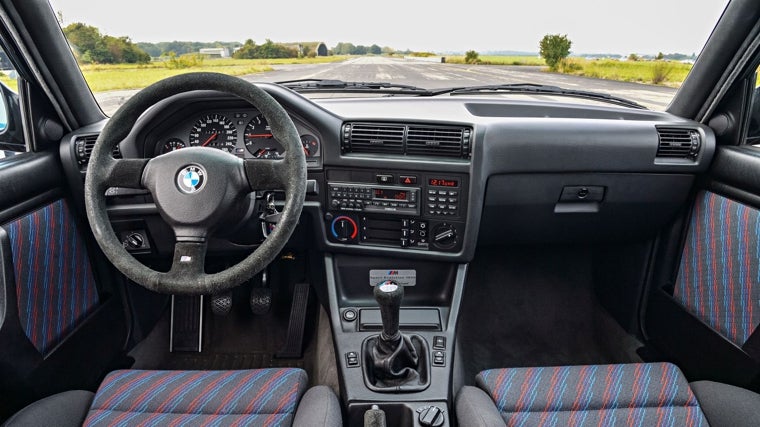 Interior of the E30 M3
SGC
Interior of the E30 M3
SGC
When the E30 M3 was introduced, the brand officially stated figures of 0 to 100 km/h (62 mph) in around 6.7 seconds, impressive performance for the time, and a top speed of 240 km/h (150 mph). But more than the figures, it's its handling that makes this car's magic. The rigid and perfectly balanced chassis offers unparalleled driving pleasure. The ideal weight distribution and precise running gear make it an absolute benchmark in terms of sensations. In tests of the time, its extraordinary stability at high speeds was highlighted, as well as the good traction and grip of the rear axle and its effective braking. However, it suffered from a certain amount of understeer in both slow and fast corners, which was easily corrected (despite steering that some, at the time, considered imprecise). Of course, it was advisable not to press the pedal to the metal until you had exited the turn and were steering straight ahead.
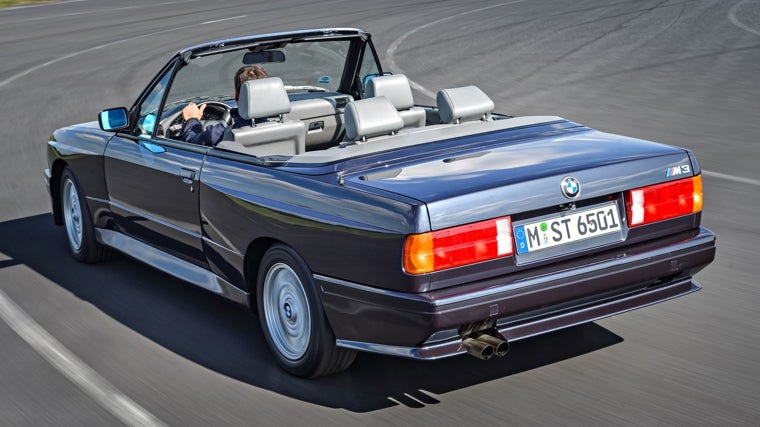 There were different body variants of the first M3, including a convertible
SGC
There were different body variants of the first M3, including a convertible
SGC
Of that first M3, there was an Evolution 1, of which 505 units were manufactured in 1987; and an Evolution 2, with changes to the camshafts, pistons and a higher compression ratio, now with 220 hp and 245 Nm of torque, of which 501 units were made in 1988. In 1990, 600 units of the so-called Sport Evolution (also called EVO 3) were manufactured, lighter and with 238 hp. There were also, launched in April 1989, two limited editions, Ravaglia (25 units) and Cecotto (480 units and 80 for the Swiss market), in honor of both drivers.
Yes, drivers and races. Its agility and robustness make it a formidable weapon on the track. It racks up victories in endurance races, including the 24 Hours of Nürburgring and Spa-Francorchamps. This sporting dominance reinforces its aura and cult status. The BMW M3 E30 is a legend today, thanks in large part to its success in competition. It won the WTCC in 1987, before going on to win numerous national championships, such as the DTM in Germany and the BTCC in the United Kingdom. Nor should we forget its role in rallying, with victories such as Bernard Beguin's in the 1987 Tour de Corse. But, for Spaniards, there is one cult image: that of the unforgettable Pep Bassas and his M3, Spanish Rally Champion in 1989.
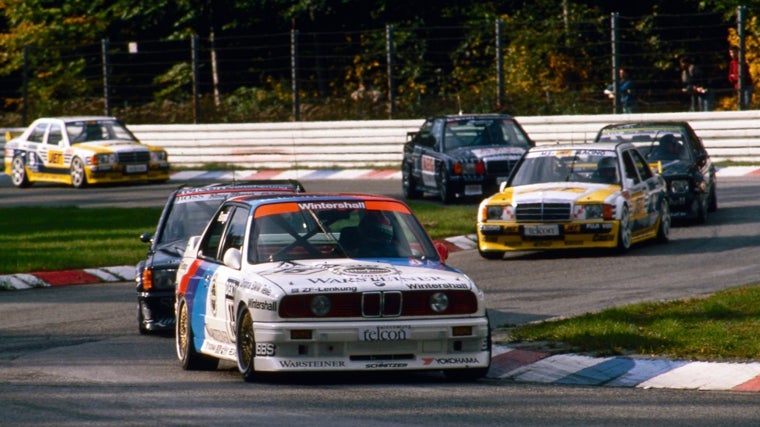 Roberto Ravaglia at the head of the pack in a 1989 German DTM race
SGC
Roberto Ravaglia at the head of the pack in a 1989 German DTM race
SGC
Although the initial plan was to produce the five thousand units needed to achieve homologation for racing between 1986 and 1991, the E30 BMW M3 was produced at approximately 18,000 units, including all versions. Incidentally, there was even a pick-up prototype…
That first M3, already at its launch, was considered a benchmark, but over time it has become a coveted collector's item, even more so in the case of limited editions.
We skip past the successive generations of the M3 and head to 2016. That year, BMW presented the M2 to the specialized press. For the uninitiated, the M2 was a 2 Series doped with anabolic steroids and designed to succeed the 2010 1 Series M Coupé. However, for those in the know, the new "M" coupé was quickly considered the true successor to the M3 that appeared forty years ago.
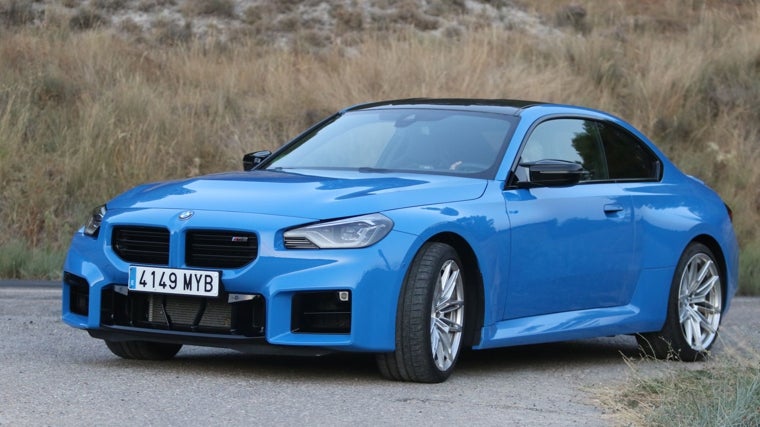 The 2025 M2, an excellent configurable chassis and a powerful inline-6 to enjoy on the road.
SGC
The 2025 M2, an excellent configurable chassis and a powerful inline-6 to enjoy on the road.
SGC
The reason the M2 occupies this place is explained by the fact that the M3, over several generations, has changed categories by increasing in power, yes, but also in size and weight, until it became, for purists, a fantastic sports grand tourer, but refusing to be a true sports car, leaving a gap, in the range and in many hearts, for the M2.
Thus, upon its launch in 2016, the M2 immediately established itself as one of the sportiest models in the BMW range, if not the best, thanks to its rear-wheel-drive architecture, ideal weight balance, optimal power-to-weight ratio, and, above all, a size very similar to that of the original M3. Definitely an old-school recipe...
It's worth remembering that the first generation of the M2 was based on the 2 Series Coupé platform. It wasn't until the Competition version that it benefited from a genuine M engine derived from the M3 and M4, boosted to 450 hp in the exclusive, limited-run M2 CS.
But today, BMW has designed the new generation (code G87) directly on the platform of its bigger brothers, the M3 and M4. The M2 takes advantage of this by using its engine block, gearboxes, and also its chassis and braking system (six-piston and 380 mm discs at the front / 370 mm at the rear).
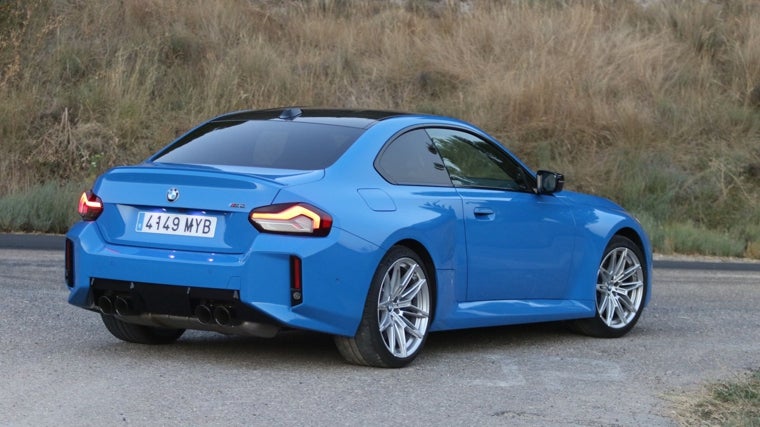 From this angle, with its flared fenders, the M2 exudes a sense of power like that first M3 from 1985.
SGC
From this angle, with its flared fenders, the M2 exudes a sense of power like that first M3 from 1985.
SGC
Compared to the M4, the new M2 is 21 cm shorter, including an 11 cm wheelbase. And the track width is practically identical. Proof of this are the 275/35 ZR19 front and 285/30 ZR20 rear tires. In fact, at 4.58 m long, the new M2 is 3 cm longer than its predecessor, mainly due to the wheelbase (+5.4 cm). At the same time, it is 4 cm wider. And, above all, with a mass of 1,800 kg, it weighs 150 kg more (or even 225 kg more than the M2 CS), reaching the weight of an M4...
We mentioned that the M2 was introduced in 2016, and the slightly larger second generation arrived in 2023, which was just updated in 2025. So we're driving a brand-new model.
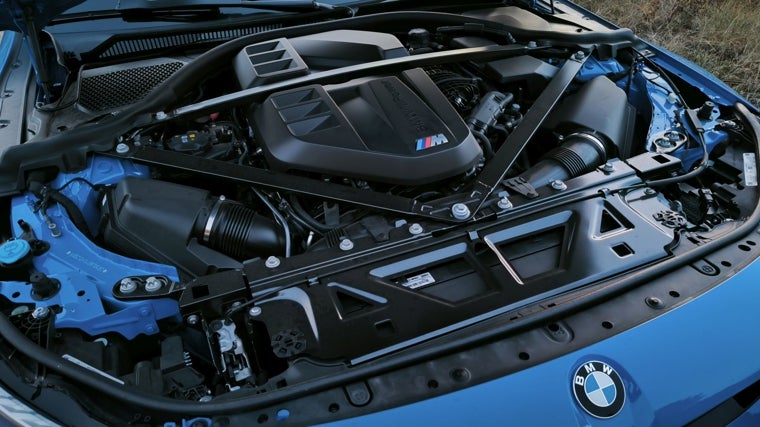 Six cylinders, 480 hp, without any type of electric assistance, transmitted to the rear axle…
SGC
Six cylinders, 480 hp, without any type of electric assistance, transmitted to the rear axle…
SGC
At the engine level, the six-cylinder turbo gasoline one hundred percent thermal (not the slightest hybridization) of this M2 2025, gives 480 HP, twenty more than before and at the same speed, and the torque is 600 Nm (in the automatic version because in the manual it remains at 550 Nm) between 2650 and 6130 rpm (compared to 2650 and 5870 before).
The power-to-weight ratio is 3.75 kilograms per horsepower. The M Steptronic automatic transmission takes 0.1 seconds to accelerate from 0 to 100 km/h (62 mph): 4 seconds, and the manual transmission takes 4.2 seconds. The acceleration to 200 km/h (124 mph) is 0.6 seconds faster: the automatic M2 takes 12.9 seconds, and the manual 13.7 seconds. As for the top speed, as with the 2023 version, the M Driver's Package increases the speed to 285 km/h (155 mph) instead of 250 km/h (155 mph).
This engine features a number of details taken directly from racing cars, the impact of which is most clearly evident in its lightning-fast response, appetite for revving, and high-performance capability in track use. These details include an extremely rigid closed-deck block, a lightweight forged crankshaft, cylinders with a wire-arc-sprayed iron liner, a 3D-printed cylinder head core, and a cooling and lubrication system tuned to withstand the demands of a track without flinching.
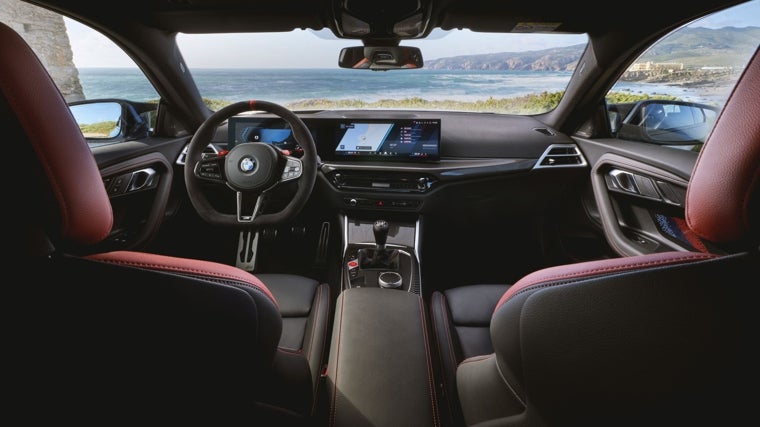 The driving position is perfect.
SGC
The driving position is perfect.
SGC
Externally, the 2025 M2 changes include the black exhaust tips, the M2 emblems, and a new range of paint finishes. Inside, the air vents and dashboard trim have been updated to a gray finish, and the available colors are available in aluminum or carbon fiber.
The steering wheels (Alcantara upholstery is available as an option) have flattened bottoms. The M Carbon sport seats can be ordered separately from the M Race Track package. The multimedia system now runs on the 8.5 operating system, which has a different graphical interface.
But above all, the ambiance, the sporty feel that the entire interior conveys, the carbon fiber inserts, the controls, the steering wheel... it exudes sportiness down to the last detail. A true invitation to drive.
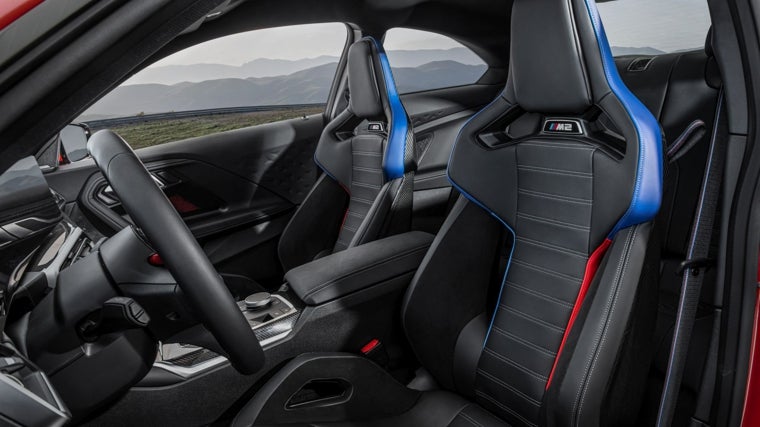 Sports seats allow us to literally become one with the car.
SGC
Sports seats allow us to literally become one with the car.
SGC
The new (2023 and updated in 2025) M2 awaits us. The racing-style front bucket seats are perfect: adjustable, they make us feel like one with the car, a perfect union with it. The driving position is ideal, as always with BMW.
And we set off. The cool note of the exhaust sets the tone. The Beatles were provocative with their music in the early 1960s; now the M2 is provocative in these times of complexes and prohibitions. We set off. Yes, like the M3 and M4, if we're gentle with the right foot, the M2 is perfectly suitable for everyday use.
Perfectly soundproofed, firm but not overly so, it even benefits from a trunk large enough and four seats to allow for daily use without too many problems. The icing on the cake: its 6-cylinder engine proved surprisingly economical on the highway, averaging "only" 8.3 liters per 100 kilometers, very good for a machine with almost 500 horsepower.
Of course, it's another matter entirely. That engine is practically bursting at the seams with torque, so much so that you don't know what to do with it: in eighth gear with the automatic transmission, you just step on it and it pushes, it always pushes...
On the other hand, this also means that, once the revs are slightly higher, the M2 displays a (very) responsive and playful handling. Thanks to its 2.75 m wheelbase, 11 cm shorter than that of the M3 or M4, it is significantly more responsive than the latter. On slippery terrain, its rear axle sometimes spins even in a straight line and can spin slightly even with all assistance systems activated.
And be careful when you deactivate them, especially since the M2, at 1.8 tons, is no longer a lightweight. That said, once we have the many dynamic settings adjusted to our liking, its mechanics, its lively and precise steering, the grip provided by its wide tires, the stability resulting from perfectly designed suspensions, and its sharp brakes make it an incredibly fun and efficient machine, with almost no rivals in the category.
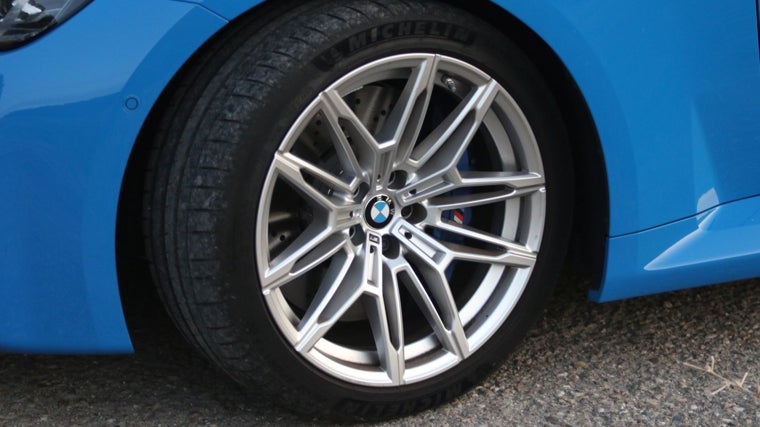 Behind the wheels are the fantastic brake discs, 380 mm at the front and 370 mm at the rear.
SGC
Behind the wheels are the fantastic brake discs, 380 mm at the front and 370 mm at the rear.
SGC
Without a doubt, an M2 has never been so efficient. But one request to BMW: may the passage of time not lead to an increase in weight, size, and overall comfort that would inevitably impair the experience… Cars like this aren't made many anymore, and that must be taken care of, not betrayed.
ABC.es





